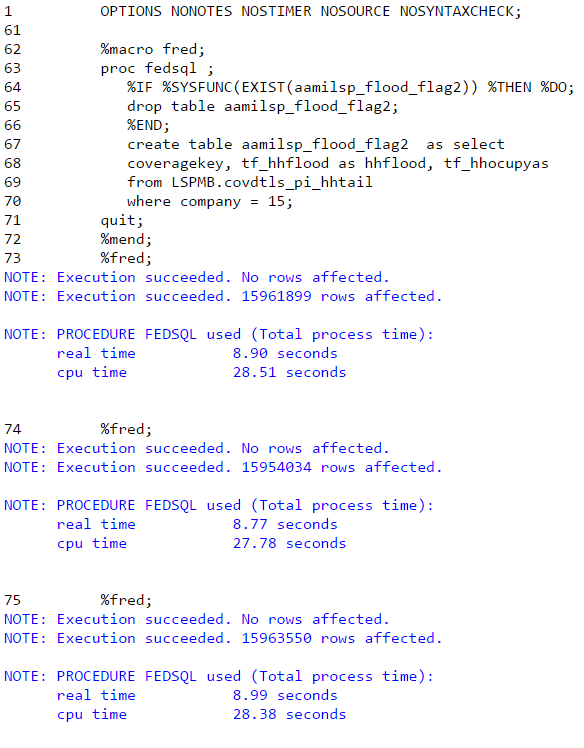- Home
- /
- Programming
- /
- SAS Procedures
- /
- Erratic proc fedsql behaviour
- RSS Feed
- Mark Topic as New
- Mark Topic as Read
- Float this Topic for Current User
- Bookmark
- Subscribe
- Mute
- Printer Friendly Page
- Mark as New
- Bookmark
- Subscribe
- Mute
- RSS Feed
- Permalink
- Report Inappropriate Content
Hi,
I am using SAS 9.4 and have been experimenting with PROC FEDSQL and have been experiencing some weird results as shown below in the log:
As you can see everytime I run it I get a different result (I manually checked the dataset and the rowcount does match the log so that part is consistent). Changing the code back to using proc sql I get the expected row count every time it is run.
Does anyone know why fedsql is giving random results? The input datasets are static and have never changed.
Many thanks,
Reece
- Mark as New
- Bookmark
- Subscribe
- Mute
- RSS Feed
- Permalink
- Report Inappropriate Content
- Mark as New
- Bookmark
- Subscribe
- Mute
- RSS Feed
- Permalink
- Report Inappropriate Content
Hi Reece,
I will follow up on this. What data source is the LSPMB library accessing? Also what SAS 9.4 release and platform are you using?
Sylvia
- Mark as New
- Bookmark
- Subscribe
- Mute
- RSS Feed
- Permalink
- Report Inappropriate Content
Hi Sylvia,
LSPMB is given by: LIBNAME LSPmb SPDE "/data/SPDE/M_B_PNCHPI" partsize=1028;
%PUT sys-ver = &sysvlong and OS = &SYSSCP &SYSSCPL;
sys-ver = 9.04.01M3P062415 and OS = LIN X64 Linux
Many thanks,
Reece
- Mark as New
- Bookmark
- Subscribe
- Mute
- RSS Feed
- Permalink
- Report Inappropriate Content
Reece,
Set the ANSIMODE option in the PROC FEDSQL statement. That should resolve the discrepancy.
Sylvia
- Mark as New
- Bookmark
- Subscribe
- Mute
- RSS Feed
- Permalink
- Report Inappropriate Content
Dear Sylvia,
what is the syntax for doing so? Would you mind to give an coding example? Thanks!
- Mark as New
- Bookmark
- Subscribe
- Mute
- RSS Feed
- Permalink
- Report Inappropriate Content
Simply add the keyword to the PROC FEDSQL statement:
proc fedsql ansimode;
When the underyling driver is SPD Engine, using ANSIMODE changes the location where the WHERE clause is processed. Normally, the driver processes the request. When ANSIMODE is specified, because SPD Engine uses SAS missing values, the driver rejects any WHERE clause, and the FedSQL driver handles the WHERE clause instead.
If this doesn't work, please file a software problem report.
- Mark as New
- Bookmark
- Subscribe
- Mute
- RSS Feed
- Permalink
- Report Inappropriate Content
Thanks, but unfortunately, your proposal does not fix the problem in my case. Please, would you take a look at my post https://communities.sas.com/t5/SAS-Procedures/PROC-FedSQL-with-stochastic-results/td-p/501773 ? The problem is the same with und without using SPDE.
April 27 – 30 | Gaylord Texan | Grapevine, Texas
Registration is open
Walk in ready to learn. Walk out ready to deliver. This is the data and AI conference you can't afford to miss.
Register now and save with the early bird rate—just $795!
Learn the difference between classical and Bayesian statistical approaches and see a few PROC examples to perform Bayesian analysis in this video.
Find more tutorials on the SAS Users YouTube channel.
SAS Training: Just a Click Away
Ready to level-up your skills? Choose your own adventure.



